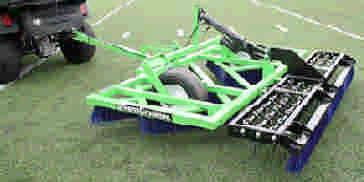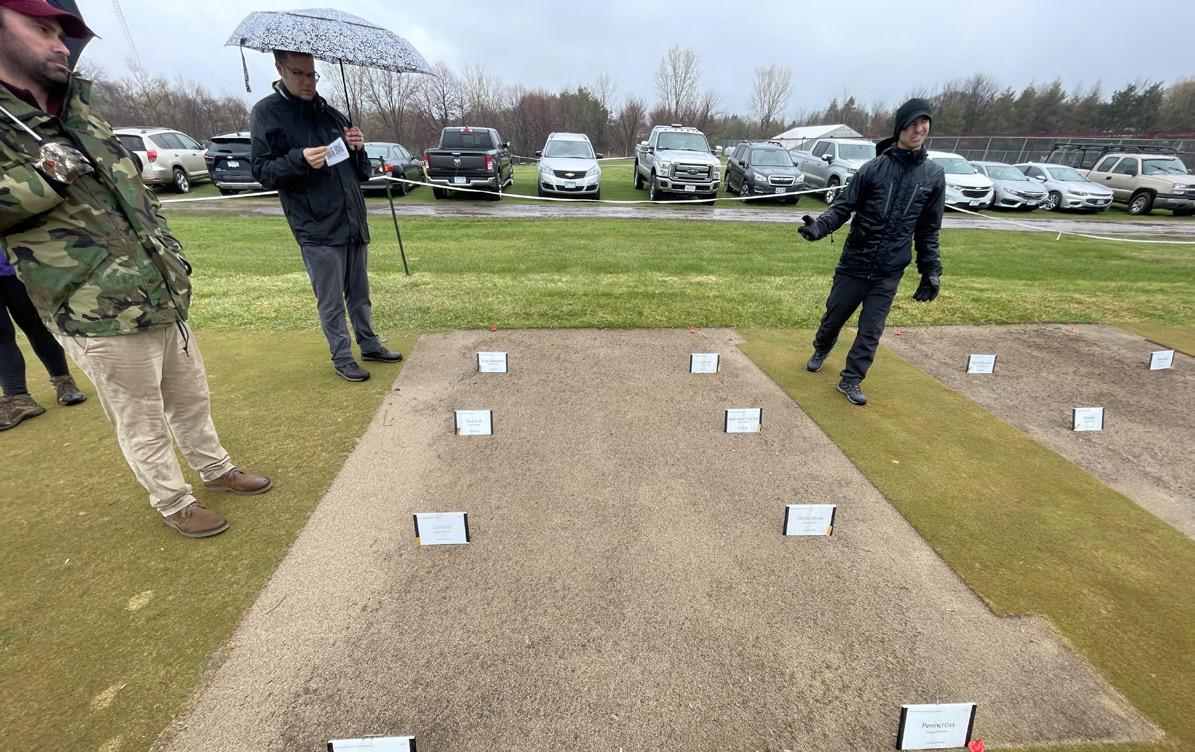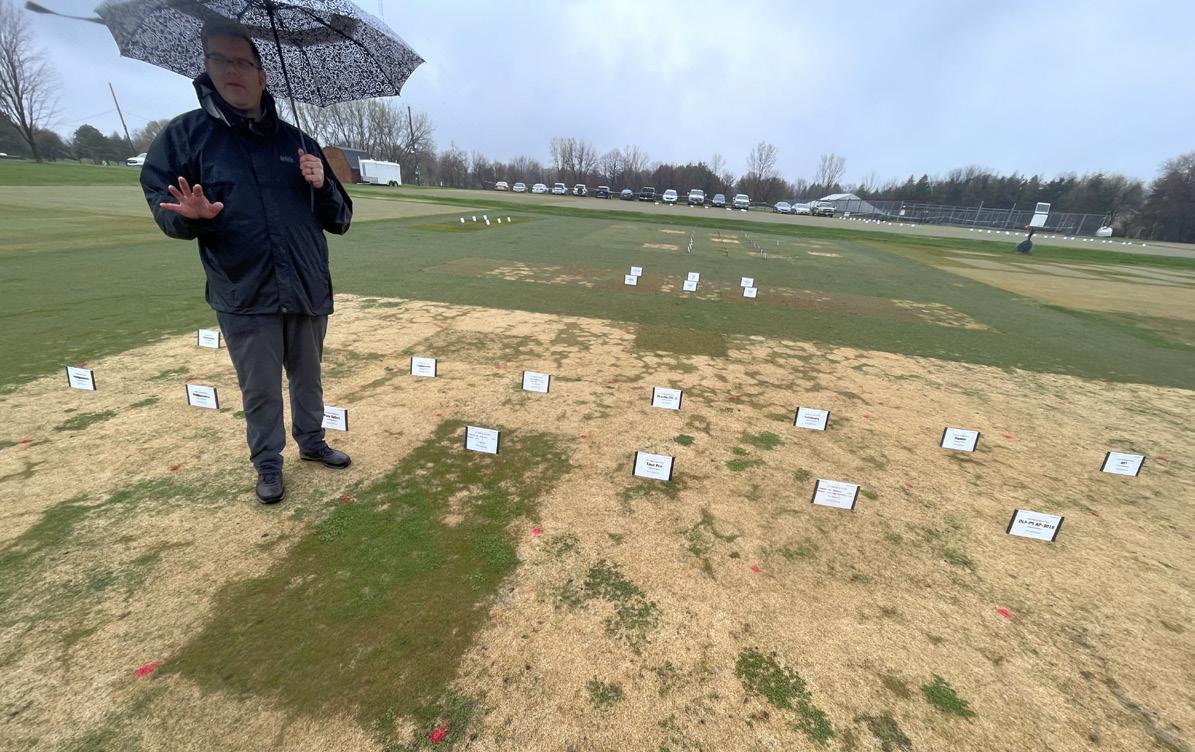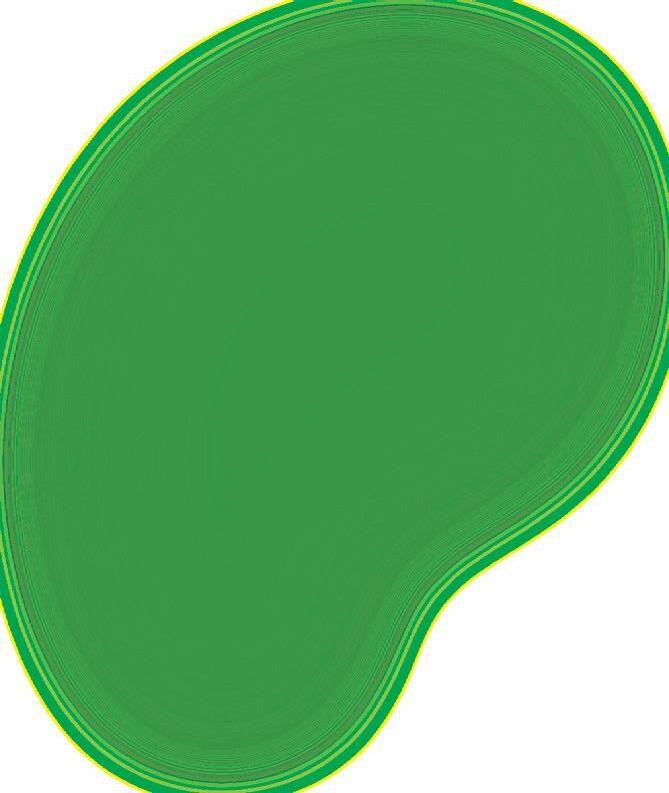HOLE NOTES
The Official Publication of the MGCSA
UMN:

On the Cover: First Green Soil Demos
On this page: Green Haven Golf Course

The Official Publication of the MGCSA
UMN:

On the Cover: First Green Soil Demos
On this page: Green Haven Golf Course
Hole Notes (ISSN 108-27994) is digitally published bi-monthly, 6 issues per year, by the Minnesota Golf Course Superinendents’ Association, PO Box 2028, Maple Grove, MN 55311. Chris Aumock Publisher. Please send any address changes, articles for submission, advertising and concerns to chris@mgcsa.org.

Board Members
President Matt Cavanaugh
Vice President
Mark Michalski
Secretary/Treasurer
Nikk Dickerson
Ex-Officio
Mike Sonnek
Director John Cameron Director Jacob Dixon
Director
JT Hauser
Director Sally Jones
Director
Geoff Jordan
Executive Director
Chris Aumock
Editor
Matt Cavanaugh
mattc@umn.edu
June 2023
Featured Articles
National Golf Day Recap By: Adam Lesmeister and Nick Klinkhammer

Good Enough By: David Marquardt, Dirt-n-Turf Consulting
Roll it Forward By: Michael Brual, CGCS, Green Haven Golf Course
First Green at Benson Golf Club By: Sally Jones, Benson Golf Club
Get to Know ‘Em
By: Kevin Gruber, Little Crow Country Club Page 42-45
Wintertime Wonderings: Roundtable Roundup
By: Dr. Michael Barnes, UMN Page 48-52
Presidential Perspective P. 2-4
By: Matt CavanaughFrom the High Grass P. 54-55
By: Chris AumockI’m wiped out and because of that I have been avoiding getting this article written. I don’t mean to delay such things, but being tired can have a big impact on one’s life. Unfortunately, it can also have an impact on the lives of others as I can actually hear Chris mumbling under his breath at me from his new house just down the road. I’ll make it up to him.
As usual, work is busy with eight shotguns in the past twelve days and a whole lot of hand watering, irrigation repairs, and projects in between all that play. For me, work is always the easy part of my life and I feel very blessed about that. I also feel

very blessed to be all in on 11 and 9 year old baseball as well… but that is the part that wipes me out. I’m sure many of you are going through the same fate right now as well. I currently get home from work and I’m at the ballpark until 9:00pm most nights. Plenty of time to write an article for the MGCSA, right?
I enjoy the time with my boys but add 24 more boys to the plate and the stress level can rise. I’m full-on coach for my eleven year old’s team. The meathead factor is high on this team. All the kids are great, but it is a challenge for me to stay calm when their focus starts to drift. However, I also find that my patience can
be quite low when all this work/ life stuff is making me tired. Six weeks into baseball I have made my older son cry twice at baseball. I often think that I’m providing constructive criticism to help him learn and grow as a baseball player. In reality, I’m frustrated that he made a bad play and I wished he would have been better in that moment and I can be quick to talk (okay, it’s a forceful suggestion) when I’m tired instead of supportive.
I initially was an assistant coach for my younger son. He and I have an interesting relationship. My wife likes to remind me it’s because we have very similar personalities. He’s a fiery kid that does not like to fail and certainly does not like it when other people see him fail. There was one such incident at his second game when I happened to be the first base coach. He’s a good hitter but was facing a pitcher that was throwing harder than he had ever seen. Strike three swinging…he gives a little shout… turns to walk to the bench… and then launches the bat into the fence. In the moment…at first base…I completely lost my
mind on him. Shouting in front of everyone to pick up the bat and yelling my frustration at my nine year old. He cried…Mom went to console him…I got up to him and continued to remind him of my disappointment. Did he deserve a talking to, absolutely. However, I was extra tired, it was hot that day and I know that impacted how I reacted to the situation. Unfortunately, we are often short to the people closest to us.
There is currently very little time for extra activities beyond work and youth baseball. However, I have been able to find a little time to participate in a few MGCSA events with the Carnival at the TPC, my first match of the Don White and an MGCSA/ WGCSA outreach event at Lake Wissota Golf Course in Chippewa Falls, WI. At these different events I’m reminded that so many are going through the same things both at work and at home. It is great to have conversations about family, work, and all the other random topics. I’ve been able to have several good conversations about how other superintendents deal with the busy youth lives
that many of us have our kids involved in and how it can make everyone in the family tired.
Here a some of the conversation I have been able to have getting together with my peers:
1. Tree removal
2. Renovation experience
3. Paclo applications
4. Equipment costs
5. Why country is the worst music
6. Irrigation problems
7. Irrigation costs
8. Poa Cure


KEY FEATURES:
• 24.7 hp FT4 compliant liquid-cooled diesel engine
• 22" QA5 cutting units for a 100" total width of cut
• 3-wheel, smooth tire configuration with standard grip all-wheel drive
• Passcode-protected TechControl display
9. And of course…youth sports
I hope to continue to find the energy to have conversations with many of you. It certainly helps me to decompress and remind myself that others are having the same issues and challenges that I am both at work and home. If you were wondering, it’s 9:29pm, my youngest son lost 12-7, no bats were thrown but several clumps of dirt were tossed in the air…which drives me crazy and he knows it.
If you have a stewardship project that you would like to implement on your property, submit a request for up to $3,000 from the MGCSA to help! Follow the link below for full information. Submit applications soon, as the deadline is June 30th!

























Make a career out of your passion for golf and the outdoors with affordable options offered fully online.
Program offered completely online
Faculty experts with industry experience
Designed for students looking to develop the technical skills needed to maintain turfgrass environments along with the management and organizational skills necessary to advance your career.
Prepares students with the technical skills to work in several different areas including, but not limited to athletic fields, golf courses and parks.
Make the outdoors your office
The 2023 National Golf Day occured from May 8-10 in Washington D.C. MGCSA was proud to support a strong contingent of members to represent Minnesota for this event. Thank you to our delegation for taking the time to be involved with this important initiative. From Left to Right
above; Kurtis Kunkel, Olympic Hills Golf Club, Chad Blank, Hazeltine National, Matthew Becker, Spring Hill Golf Club, Mitchell Linnerud, Rochester Golf & Country Club, Nick Klinkhammer, Golden Valley Country Club, Adam Lesmeister, Clesens, and Aaron Cabanaw, Inver Wood Golf Course.

National Golf Day 2023 marked my second tour representing the MGCSA in Washington D.C. Much like my experience in 2018, the American Golf Industry Coalition and the GCSAA did a truly fantastic job planning the events, the service project on the National Mall, and the meetings with more than 250 Senators and Representatives. I cannot fathom the amount of time and energy they all pour into this event year after year.
Over 200 Superintendents, Assistant Superintendents, General Managers, Golf
Professionals, Manufacturer Representatives, Distributor Representatives, and other Golf Industry members from almost all 50 states represented our industry for three days in Washington. Much like the Minnesota Day on the Hill, the golf industry is the talk of the town on capitol hill on National Golf Day.
My experience the second time around was very similar to my trip in 2018, as the format was about the same. Although I couldn’t fly in early enough to be a tourist for a couple of hours on Monday like in 2018. I had the pleasure of meeting many new

industry peers and getting to know our Minnesota delegation better as well as catching up with many others that I met in 2018 and at GIS over the years. I even ran into a couple of guys that I met when I worked in Texas over 10 years ago.

It was refreshing to see that some of the same issues and proposed bills that we have been working on over the past couple of years are still being talked about. And a few of them are getting very close to becoming reality. It really

shows that what we do when it comes to advocating is being heard and being considered.
The National Golf Day experience isn’t all work, with the service project and congressional meetings. Monday night we were all treated to a nice dinner for the welcome reception and Grassroots Ambassador awards. Tuesday, after the service project, Mitch Linnerud and I were able to walk about the National Mall to check out the various monuments. Tuesday night we were invited to a Congressional
Reception at the Senate Office Building where we were treated with hors d’oeuvres, and an open bar, as well as a visit from Representatives Nancy Mace and Richard Hudson.
I often get asked why I get involved with advocacy. Whether it be participating in the Minnesota Golf Day on the Hill, National Golf Day or why I am/was a Grassroots Ambassador. And for those of you that know me, it’s not that I want to be involved in politics, or that the issues are all worth talking about, or are even being heard or making a difference. It’s because of something that Jack Mackenzie instilled in my head over 7 years ago; you need to



have a seat at the table. Whether you like that answer or not, it’s the truth. As an industry, we must show up. There is a strength in numbers, and in advocacy, numbers are paramount.



I will end with this. Get involved in some way. Start with the Minnesota Day On the Hill. Meet your Representatives and Senators that work for YOU and want to hear from you. Get to know your fellow industry peers, you get to spend a whole day with them that day! I have participated in every Minnesota Golf Day and now two National Golf Day’s, I’ve been a Grassroots Ambassador for 5 years and I’ve sent many emails back and forth with my Representatives






and Senators. They remember me. They remember my story and what I do for a living. Building that relationship is the first step. After that, making the ask when you need something is so much easier.
Thank you to the MGCSA and the membership for helping a few of us to attend National Golf Day. If you ask anyone who has attended, it really is an unforgettable experience.
 Nick Klinkhammer, Assistant Superintendent, Golden Valley Country Club.
Nick Klinkhammer, Assistant Superintendent, Golden Valley Country Club.
It was an honor being a part of National Golf Day through the
Excel Leadership Program with the GCSAA. With golf being a passion in my life, it was exciting to speak with our congressmen and women representing our communities in our nation’s capital. The golf industry is a multi-billion dollar industry; with the latest surge of golfers due to Covid it has become ever-important to advocate for the different issues we face. Being able to learn what other areas of the country are dealing with in their state, volunteering with a national mall project, and networking with many different individuals was an experience I’ll never forget. It was my pleasure to represent GCSAA, MGCSA, and Golden Valley Country Club.







Thank you to host Superintendent Joe Rolstad, his team, and all of our Affiliate supporters!!



Another beautiful day was in store for this years spring field day participants!! Thank you to the UMN team for your continued support of local turfgrass research!




See how you can the only mobile-first irrigation system on the market.
















IRRIGATION HAS ALWAYS BEEN IN YOUR HANDS. NOW IT LITERALLY IS.
Ed. note: Article originally printed in the Midwest Association of Golf Course Suprintendents magazine, On Course, Dec./Jan. 2023.

Have you ever built a new house?
Being recently retired, or semi so, we relocated to Central IL and built a new home. Now if you’ve ever been through this process, then you know how enjoyable
it can be to wander through the house and watch the changes. From a hole in the ground, to foundations poured, and before you know it, the walls are up and they’re starting to put the roof on. It’s an exciting time for sure.
Now for us, this wasn’t our first new construction. We had built 3 new homes prior, as well as
added 800sf onto our last home. In these past constructions, I built about 90% of the homes myself, leaving the electrical, plumbing and heating and such to those who have more expertise. But for our new home, our retirement home, well, that was an undertaking I was no longer up to. While not doing the lifting, nailing and such, I did, as mentioned, walk through regularly, inspecting if you will, the process and the work being done. And that’s where the frustration came in.
Now understand, we love our new home, and the construction turned out fine, and those items I wasn’t too pleased about, well, I have the ability to improve. Items like a few poor plaster seams, doors that rub on the carpet, locks that don’t latch quite right, and painting that needs a new brush and roller. Again, having been through this many times before, these are all items we’re capable of. All this to say or ask; why is it so easy to say, ‘that’s good enough’?
after we’ve returned from a long day on the course, and we do just enough to get by. Like my carpenter, who did as I asked and cut off the bottom of our master bedroom door so that it wouldn’t drag on the carpet. Yes, the door didn’t drag, but the edges were all splintered, requiring me to remove, sand and repaint after he was gone. ‘That’s good enough’ is the attitude that so many take with the things they do for others, but would never accept for themselves.
We all do it don’t we? Maybe it’s a chore around the house,
Unfortunately, ‘that’s good enough’, is a trend that I observed creeping further and further into golf course maintenance over my last many years of consulting. Now to be clear, we never want to paint any group with the same broad brush and that’s not my intent. To be sure, beyond the relationships themselves, one of the things I most enjoyed during my consulting career, was observing the effort and expertise of the professional golf course superintendent. Unfortunately, in my last few years of running a full schedule, it seemed that more and more
managers were allowing less than they were capable of. Let me share an example.
I recently ran into a friend who is a member of an area club. His comment to me, was that he didn’t know how good their club could be. The back story; this was without question the top club in the area, and the superintendent, who had been there for many years, did a great job. But try as I might, I couldn’t get him to move to the proverbial ‘next level’. Knowing that he served the best club in the area was ‘good enough’. Fast forward to his retirement, and his replacement came in with new energy and a desire to make the course as ‘good as it could be’, instead of accepting, ‘that’s good enough’. That’s what amazed the member I ran into, who could never imagine that the course could get any better than it already was.
Now as we all know, this example isn’t an isolated incident. Time and time again we have observed the ‘new guy’ coming in with new vim and vigor, excited to take playing conditions to the ‘next level’. And to be fair,
there are many reasons why the previous superintendent might not have pushed a bit more. We know that things like budgets and member conflicts are often reasons that are beyond the superintendent’s control, and we all get that. But as mentioned, it seems that complacency has crept further and further into our profession, as has the attitude, that ‘that’s good enough’.
Similarly, we can also relate to how often we see guys a bit tired, burnt out, and in a ‘that’s good enough’ mood, but then move to the next course with a new sense of energy and desire. That’s great to see, but I’ve often wondered why they hadn’t put in the same effort at the course they left. Certainly, there are many possible reasons, but I wonder if the attitude of ‘that’s good enough’ didn’t begin to take over the day-to-day operation.
repercussions of our ‘that’s good enough’ attitudes:
For ourselves, it seems to me that when we sell our abilities short, we sell ourselves short.
As opposed to seeing how good we can be, and how good our courses can be, we let ‘that’s good enough’ become the norm. This carries beyond course conditions and into continued education. Fertility management is a perfect example of this, as I have watched time and time again as superintendents don’t know how to read fertilizer labels and understand the different forms of nutrients that are available to them. Far too often they get used to letting their vendors make many of those decisions, instead of taking the time to educate themselves into the varied responses that each form delivers.
(That’s for another article)
For our staff members, well they see our attitudes and complacency and they too begin to get satisfied with their performance. We have all observed this as the new superintendent moves in, and there’s nothing but staff conflict when they are pushed to perform past ‘that’s good enough’.
years ago there was a more conscious effort to mentor assistants and staff members so that they could reach their full potential. Many years ago, a client told me that when he became an assistant, he was told plainly that he’d be gone in 3 years. He’d either be ready to be a head superintendent elsewhere, or he’d be with another club as an assistant. This superintendent truly mentored, pushed, and taught his staff, that ‘that’s good enough’ could never be part of the job.
Along with this, is the issue of mentoring. It seems to me that
For our clubs, well they are paying us to preform at the highest level we’re capable of. Yes, I get the fact that many might be under paid, but when we take the job and agree to a salary, it’s with the premise that we’ll do the best we can. And as we all know, most members also play many other clubs, which means that beyond golf, they also play the comparison game. It’s not at all unusual for clients to ask me what other clubs are doing, because members who played next door are never shy about telling them about the neighboring
clubs playing conditions. Fair or not, that’s what goes on and we’re all aware of it.
In the same vein, I’d be remiss if I didn’t mention how often we all let pride be the cause of our ‘that’s good enough’ attitudes. Stay with me as I try to explain. As mentioned, one of the conversations I could always count on, was that question of ‘what is the course down the street doing’. And what I always tried to get clients to do, is to go see for themselves! Far to often pride becomes our limiting factor to learning and getting better. It becomes easier to say ‘that’s good enough’ with our practices and education, because pride stops us from asking questions of others, so that we can learn more and do more. I think you see what I mean.
Yes, golf is our common denominator and why we’re sharing this here. But the reality, as we all know, is that ‘that’s good enough’, can be found in every walk of life. I’ve shared a few comments about my builder, but we all have experiences with the waitress, the service
counter, the cashier, and so forth. And as mentioned, whether it’s our common connection of golf course maintenance, or any place else, we never paint everyone with the same assuming broad brush. We all know and respect those we meet who are constantly going above and beyond and they are to be appreciated.
The take home is that each one of us needs to examine for ourselves, those areas where we are falling short of our potential and abilities. Saying ‘that’s good enough’ limits our efforts for our clubs and staffs, that’s true. But more importantly, it limits who we are and what we can be. Being the best we can at work, overcoming the obstacles of budget, labor, and the clubhouse, shows us that we can also overcome the obstacles that the rest of life places before us. It would be my hope, that each of us would end our days knowing we did the best we could. It would be my hope, that we could all be examples for those around us, regardless of where we find ourselves in life’s journey.



The University of Wisconsin Turfgrass Apprenticeship Program (TAP) consists of a 12-week, in-person educational bootcamp and a field-based apprenticeship at a golf course, athletic facility, or other turfgrass facility. The program provides participants with the hands-on, real-world experience needed to succeed in the turfgrass industry. Successful completion of both the bootcamp and the apprenticeship is required to earn the Turfgrass Apprenticeship Program Certificate.
The bootcamp takes place over two 6-week terms during the late fall and winter. The fall term will begin the first week of November and end in mid-December. The winter term will begin the second week of January and end in late February. Each week will have class on Tuesday, Wednesday, and Thursday from 10 AM until 3 PM CST with a 1-hour break for lunch.
Program cost is the same for in-state and out-of-state students. Check the website for current rates. Housing is not provided by UW-Madison, but we provide a number of affordable hotel options in the Madison area.
Significant scholarship funds will be available to support student tuition and housing costs from a variety of turfgrass associations. More information on scholarships and how to apply for them will be provided in the first week of class during the fall term.
Students in the TAP are required to complete a field-based apprenticeship at a golf course, athletic complex, or other turf management facility of their choosing. A list of tasks to complete during the apprenticeship have been developed in cooperation with associations in the turfgrass industry and can be viewed on the program website.



Please visit https://turf.wisc.edu/academics/ and add your name to the enrollment form. Alternatively, contact Dr. Soldat or Dr. Koch via email (djsoldat@wisc.edu / plkoch@wisc.edu). The deadline for enrollment in the fall term is October 15th.


Thank you host Superintendent Kevin Gruber and his team!




$25 PER PLAYER

LE SUEUR COUNTRY CLUB

MONDAY, AUGUST 14TH
10:00 AM SHOTGUN
HOST SUPERINTENDENT: TOM MEIER

INLCUDES: 18 HOLES OF GOLF, CART, AND LUNCH!
REGISTER YOU AND YOUR STAFF FOR A CASUAL ROUND OF GOLF WITH A FUN TWO-PERSON TEAM FORMAT.
PROXIMITY PRIZES!
REGISTER ONLINE AT MGCSA.ORG. NON-MEMBERS ARE WELCOME.
EVENT IS ELIGIBLE FOR 2023 MEMBER REBATE PROGRAM.
EVENT SPONSORED BY:
The MGCSA Board of Directors is working hard to reduce limitations to participation. In-person events are essential to the growth of our industry and the professionals within it. MGCSA has the opportunity to support those engagement efforts by implementing a member rebate program this year for all class members. We are offering an event registration rebate of up to $35 to all class members. This will allow for free or reduced entry into one of our association events!
Use Rules:
- Must be active MGCSA member. Use will be monitored and recorded. One time use only, regardless of event registration costs, no redeeming cash value.
- If using credit, the individual must register separately by choosing that ticket option when signing up for an event and entering the promo code below. Member cannot use credit within a group registration.***
- Credit will be good for one calendar year, April 1, 2023 - March 31, 2024.
- Applicable to most MGCSA events, except Don White Match Play, The Wee One and The Scramble.
Not currently an annual program, will run for the one-year period stated above
The MGCSA Board of Directors has adopted a Reserve Fund Policy, with an Excess Reserve Policy included within, to manage our investment account. The goal of this policy is to create a sustainable use structure for incorporating those funds back into the operating budget and association plans. We will be utilizing earnings from our reserve fund to help subsidize the cost of these events along with other


Where is this funding coming from?
Spring or summer, you have to be ready for whatever weeds the season throws at you.
***There are limiting factors in our website system that cant support certain group registration scenarios
Cool-weather broadleaf weeds call for the proven performance of SpeedZone® EW Broadleaf Herbicide for Turf. And when summer brings grassy weeds to the party, Q4® Plus Turf Herbicide for Grassy & Broadleaf Weeds has you covered.



Elk River, MN • 763.441.1100
www.plaistedcompanies.com

Our Sands meet USGA guidelines and are available with green pigment. Custom mixes can be blended for your individual needs using our 4-bin computerized Accublender.

Our bunker sands are always washed and screened. Choose from:


•Plaisted Bunker Sand Natural Tan
•Plaisted Pro Bunker Sand Blend Natural Tan
•700 Best Signature 100% Crushed Off White

•900 Best Signature 100% Crushed White
Our mixes all use USGA sand and a combination of fine grade peat and screened black dirt. Chose one of our popular mixes or we can custom blend one.

•USGA Coarse Gravel - A great bridging rock used as a drainage layer.
•Construction Sand & Peat Mixes - 50/50, 60/40, 70/30, 80/20, 85/15, 90/10
•Construction Sand & Black Dirt Mixes - 50/50, 70/30, 80/20
•Construction Sand/Peat/Black Dirt Mixes - 1-1-1, 60/20/20, 70/20/10, 80/10/10


•3/8” with fines river rock
•Class II buff limestone or red rock
•Class II, III, IV crushed granite
•Class 5 gravel
•Recycled concrete, crushed asphalt, conbit
.
•Dry topdressing sand
•Dry tournament topdressing sand
•Dry green topdressing sand
•Dry early-green black topdressing sand
•Dry 70/30 green divot mix

Our mixes contain highly sought after ingredients like composted pine bark, peat and screened black dirt. They are ideal for flower beds, tree and shrub growth or whatever growing application you may have.


Our soil amendments are mixed with existing soils, and promote healthy root growth and water retention.
We offer 8 varieties of mulch and 11 varieties of landscape rock to add the pop and class your course deserves. We also carry quality hardscape brands and natural stone options that offer exceptional strength, durability and the kind of long lasting beauty that will make your clubhouse a coveted destination for golf and events.

•Mulch
•Decorative Rock
•Mason Sand
•Pavers
•Retaining Walls
•Firepits/Outdoor Fireplaces
•Boulders
•Monument Stones
•Water Features
We own our own fleet of 50 GPS tracked trucks making delivery dependable, efficient, and timely. We have a truck for any job.

I was introduced to Golf early in life by my Dad, at the time he was the President of Pipestone Country Club and in the process of building a new clubhouse. By the mid 1970’s, he became the Manager, Club Pro, Chef, and finally in 1980 the Superintendent. Both my Mom & Dad raised my two sisters and

myself at the club. We cleaned, set up for banquets, bartended, washed dishes, cooked, and eventually at 13 I began working on the golf course along with clubhouse duties in the evenings. My Dad and I would travel SW Minnesota, NW Iowa, and Eastern South Dakota playing in the weekend golf tournaments

in the area, he always said he needed to support the area’s club events so they would play in the two events he hosted each year at PCC. Looking back, I now realize the valuable opportunities I was exposed to and the people we met along the way at a young age, what a way to grow up!
At that point I thought the Scotts program that Mike Redman wrote for my Dad was the gospel, and Rich Vining from Dakota Turf was the one and only guy to buy Orange equipment from. Those two guys taught my Dad and me so much and guided us along the path. My Dad was one that wanted to learn all he



could so he would travel around talking to other Superintendents when he had time. Learning from Tedd Evans & Greg Iden at Brookings Country Club, Fred Taylor at Mankato Golf Club, Gene Reiter at Minnehaha Country Club, and R Drew Demorest at both Worthington Country Club and Marshall Golf Club. In 1984 at the age of 16 years old both my Dad and I were invited to Marshall Golf Club to play in a MGCSA event and we also became members of the association on that day. 39

years later I realized that was the point I knew how I would spend the rest of my working life.
I decided that if my career was going to be turf management, I needed to further my education, so in 1986 I enrolled at the University of Minnesota-Waseca and eventually earned my degree in Landscape, Nursery, and Turfgrass Technology. Under the guidance of Brad Pedersen, the UMW staff and so many lifelong friends (including my lovely wife Sue of 30 years) I
had the opportunity to learn from and work with has been an absolute blessing to say the least. It is just a shame that they decided to close such a diverse agricultural based campus in the University of Minnesota system.
I returned to PCC after graduation to continue working with Dad for another year when the opportunity and dream of mine landed at my feet. In March of 1990, I started at Hazeltine National Golf Club at the age of 22. What an opportunity that was to learn from Chris Hague,
CGCS and the great staff at Hazeltine along with the staff of the USGA preparing for the 1991 US Open and then eventually becoming the Assistant and helping lead the staff at one of the finest golf clubs in the Midwest. I learned so much from so many great people and it also opened so many new doors and created many lifelong relationships I cherish to this day. In 1996 my dream of becoming a Superintendent came true at my first own club, Faribault Golf & Country Club. Getting my feet wet caring for and maintaining

FG&CC for 9 years while working with some wonderful staff and club members that were passionate about their club.
During my time at FG&CC I was able to serve our organization as a board member and then Treasurer of the MGCSA, and also become a Certified Golf Course Superintendent, an accomplishment I am very proud of to this day. I realized in 2005 that it was time for me to move on to my current position as Golf Course
Superintendent with the City of Anoka/Green Haven Golf Course. This was an exciting new opportunity to continue honing my skills in a different environment. A public facility doing 40,000 plus rounds of golf a year and working for a municipality. 18 years later I continue to advance my career and being looked upon and given the opportunity to do numerous projects including a new irrigation system and building a first class maintenance facility. I am also thankful to

work with a great mechanic
Dave Kramer and Assistant Brandon Howard, both of these men are passionate about what they do for a living and always have my back. Thanks guys.
I have been happily married to my college sweetheart for 30 years, Sue has been by my side supporting me the entire way, and even worked with me at Hazeltine and FG&CC as our gardener. She has put up with me at home and at work while raising our 2 kids, she must really love me! Sue and I have a son Michael Jr. (29) and a daughter Emily (25), we are both very proud of our kids watching them grow up and developing a work ethic they inherited from us.

I am so thankful for the relationships I have made throughout my career, there are too many to list but you know who you are. Fellow Superintendents, staff members, club members, industry representatives, academic leaders, contractors, agronomic advisors and many others. You have all helped in some way guide me down this path
of growing grass and more importantly being a FRIEND!
A requirement for the Roll it Forward column is for the author to nominate another individual to continue the series for the next issue of Hole Notes. I will proudly nominate Regional Sales Representative-PBI Gordon, Jeff Schmidt. Jeff has been a longtime adviser and trusted friend that I have leaned on several times over the years for his help, guidance, and friendship. I hope you enjoy his story.


MGCSA team members celebrating our win over WGCSA in the inaugural Border Battle Event!!

Thank you to our host Superintendent Bryan Wasilewski, his team, and Lake Wissota Golf Course!









 By: Sally Jones
By: Sally Jones






On May 22, I had the honor to host my very first GCSAA First Green Event at the Benson Golf Club in Benson, MN. We hosted 65 5th grade students for education, lunch, and Dairy Queen dilly bars. It was a great day and the students were really engaged in the event.
Although this was my first First Green, this wasn’t the first time I have hosted such an event. Last year, we hosted the 5th grade for a much more scaled down event. Finding the kids was quite easy. One of the 5th grade teachers serves on our club’s Board of Directors, organizes our Jr Golf Program, and is the Boys Varsity Golf Coach. He has bought into the idea of making a huge push to get youth involved in golf and it really has helped the kids feel more comfortable at our facility. There is the small fact that I spend a very small part of my winter months Substitute Teaching, so these kids were familiar with me which made the event even more enjoyable.
The event could not have been as successful as it was without the help of my wonderful peers, who made the long trip out to share their knowledge. MGCSA President Matt Cavanagnah from Rush Creek, fellow Board Members Nikk Dickerson from Faribault CC and JT Hauser from Rochester GCC, Brad Smith from Heritage Professional Products, Adam Lesmeister from Clesens, and Chris Aumock, MGCSA Executive Director. I even was able to rope in one of my staff, Brayden Haugen. Brayden has the enthusiasm for the industry we all have held. It truly is really exciting to share with him as much of what the industry has to offer as I can. I’m certain he will make a great Superintendent one day.
Each person came bearing tools and information to help with stations about geometry, soils, irrigation, cool tools, equipment, and a short golf lesson. The kids enjoyed looking into the turf canopy with the macroscopes,
climbing up on the various Toro pieces of equipment that were on display, and ripping into irrigation heads, but the most exciting thing seemed to be to learn how to set a new pin location.
A huge shout out to the GCSAA for coordinating such an awesome experience for the kids. LeAnn Cooper was a huge help when organizing the event. She sent over lots of information, including previous event agendas which I was able to easily change to tailor the needs of our event. She helped me secure a grant from the GCSAA which helped me pay for lunch for the students, teachers, and volunteers. With lunch and the cool swag bag she sent over for each of the students, and the free 9-hole passes our club donated, the kids left with some good loot and a good reason to come back and show mom or dad what they had learned.
of homemade “Thank You” cards that I received from the kids later that night. Some proclaimed their enthusiasm for the game of golf. Some simply stated that they don’t like golf, but the things they learned made it more interesting. One thanked everyone for “traveling ALL THAT WAY” to teach them about golf. But my absolute favorite is the uplifting message that simply said “Sally, You are a Queen”. I had no idea!
One of the greatest gifts I have ever received is the stack
If you have ever thought about wanting to host a First Green event, please do so. The day was greatly rewarding for myself. There is no age limit to the kids who you invite, but older kids tend to have a longer listening capacity and tend to get more out of the experience. To get involved, you can reach out to myself, LeAnn Cooper, or our First Green Liaison, Nikk Dickerson. Please consider hosting your own event soon. Our youth is our future and this is a great way to expose them to our industry. #seeitbeit
9:30 - 12:00

Join Superintendent Brian Boll and his team as they discuss the current renovation project being undertaken at Interlachen. Architect Andrew Green is also expected to be onsite for his perspective on the project. Register today to learn more about this project and the renovation process.
*Event currently open to Class Members only*

$25 PER PLAYER
PERHAM LAKESIDE GOLF CLUB
WEDNESDAY, AUGUST 16TH
10:00 AM SHOTGUN
HOST SUPERINTENDENT: JEFF FJOSNE
INLCUDES: 18 HOLES OF GOLF, CART, AND LUNCH!
REGISTER YOU AND YOUR STAFF FOR A CASUAL ROUND OF GOLF WITH A FUN TWO-PERSON TEAM FORMAT.

PROXIMITY PRIZES!
REGISTER ONLINE AT MGCSA.ORG. NON-MEMBERS ARE WELCOME.
EVENT IS ELIGIBLE FOR 2023 MEMBER REBATE PROGRAM.
EVENT SPONSORED BY:


Public or Private: Semi-Private
Number of Holes: 27 Holes
Full time employees: 8
Seasonal employees (not including full time): 18
Types of grass: Bent/Blue
Total course acreage: 260
Greens acreage: 200k

Tee acreage: 140k
Fairway acreage: 31
Rough acreage: 95
keep going up, golf will be one of those things that gets cut out.
How many years have you been in your current position? 10 years.
How many years have you been in the turf industry? 23

Where else have you worked? Prairie View GC, TPC-Twin Cities, Edina CC, Oxbow CC.
Turf School Attended (if any)? NDSU

What is one “master plan” thing you would like to change at your golf course? Bunkers. Space between green and bunkers is too large.
What concerns do you have the turf business and the future of golf? How long will this golf boom last. Costs have risen with that boom, and costs arent likely to come back down. If prices
What is needed to bring more young professionals into the industry? Changing the perception of this job being a thankless job and not getting paid enough. Everyone is after the easier money now, so promote the perks.
What piece of equipment do you want? Not a need, a want. Deep tine aerator.
In terms of industry costs (equipment, pesticides, labor, etc.) are they too low, too high or just right? They are bumped up, but everything is. The equipment side of things is getting close to being outrageous.
Have you ever met a celebrity? Who? Arnold Palmer, Jesse Ventura, that guys a different dude.
What is your favorite vacation spot? Anywhere in the mountains. I like to go west in the moutains. Yellowstone’s really cool. Hiking, camping, I go on a hunting trip every year.

What is your favorite memory of starting your turf career? My second week mowing greens on the reversible 9, I finished and washed up, my boss said you skipped this one and that one, not realizing how a reversible course works.
What is your favorite job on the golf course? Rolling greens.
What is your least favorite job on the golf course? I despise doing course setup. The first years being an assistant, I just got so much of it and you dont even need to look at the job board, just got burnt out on it.
Have you played any famous golf courses? Which ones? Not really, I like golf, but I’m not huge golfer, and I havent sought out really good golf courses.
Who is your dream foursome? My buddies that I play a tourney with in memory of my brother in laws father that past. Its a 6 man scramble. We travel from all over the place so its a good reunion every year.
The last few years have been unique, with Covid and drought. Would you like to comment on how it affected you, and how it has changed your management approach now? Everyone wants a little more flexibility in their job, everyone wants more money. Mcdonalds for $18 an hour, if thats what you want to
do. The other thing I learned is really dialing in on efficiency. Because of the higher wages, the increase in golf, trying to do the same work with less
guys and less time. We have 3 number 1’s every morning, tee times first thing on all 3 nines, so efficiency is essential.

Don’t miss our extended conversation with Kevin on this months Hole Notes Podcast!
If you would like to participate in a future Get to Know ‘Em, please reach out to Chris at chris@mgcsa.org.









































































Share your strange, funny, and unique photos from your time on a golf course? Send your images to chris@mgcsa.org.
A rare Minnesota Gator found on Little Crow Country Club!

 By: Dr. Michael R. Barnes University of Minnesota
By: Dr. Michael R. Barnes University of Minnesota
I think it’s safe to say that we’re finally out of the winter season! It might seem odd to talk about winter now when many of us are already enjoying the sunshine and warmth that follows winter. However, now that we’re at a safe distance from the ice and snow I think it’s a perfect time to reflect on what is a genuinely difficult season for people in general but specifically for turfgrass professionals of all forms, especially in the specific context of golf courses. A variety of winter stresses can have significant impacts on turf health and even result in death in certain circumstances; unfortunately very little is known both about the specific circumstances in which
winter injury occurs and what management techniques might be successful in mitigating those injuries. As part of the WinterTurf project discussed by Dr. Eric Watkins in two previous Hole Notes articles, first in May of 2020, and then in March of 2022, a broad range of researchers are working on understanding both of the above areas to help superintendents and other turf professionals understand and mitigate winter injury. One aspect of this winter-related research that was missing is the understanding of what superintendents actually do to try and mitigate winter injury. This is quite an important piece of the puzzle to be missing in terms of figuring out what and how we as researchers should
actually focus on. So as part of the WinterTurf project we, along with the help of local GCSAA chapters, organized roundtable discussions around a number of winter-related topics in Iowa, Massachusetts, Michigan, Minnesota, Oregon, and Wisconsin. The discussions were organized around understanding practices done to prepare for winter, during the winter, and then recovery after winter, with some specific management techniques and broader questions about previous and current stresses

about winter thrown in. Before diving into the results, a sincere thank you to all of you who participated, facilitated, and helped organize the roundtables! The results will be presented in three categories: Management practices, concerns & comments, and common questions.
One of the main areas of interest our team had was figuring out exactly what all of you (or none of you!) were doing to mitigate winter injury on your courses. Narrowing down the list of
commonly utilized practices is essential in focusing our efforts on the research side but also important to gauge how widespread or uncommon a management practice is for future projects. There were four practices that were nearly universal across superintendents and states.
1 - Snow mold fungicide applications - this was by far the most commonly cited practice that emerged from the discussions. There were however some nuances pointed out among individuals discussing different rates of applications,

timing, and where on the course they were taking place (e.g., greens only) but broadly this was the most universal practice adopted.
2 - Topdressing before winter - this was also nearly universal with most superintendents topdressing heavier than normal going into winter. Nuances here included the specific composition, and exactly how much was applied.
3 - Manage fall mowing practices - broadly individuals indicated adjusting mowing heights higher, although the range of mowing heights did vary from course to
A purposely flooded green to study the effects of ice encasement on greens.Photo by: Andy Hollman
course with some not mowing at all in the final weeks going into winter. 4 - Aerification in late fall - another very common practice was some kind of aerification done in preparation for winter. The specific timing, and type of aerification did vary though between individual courses. Less universal but still common practices included managing drainage, covering greens, and managing fall irrigation practices.
There were several recurring concerns and comments across the multiple discussions that are worth highlighting. 1preparation for winter is costly in terms of both time and money - this was a significant recurring theme from across roundtables and states. The vast amount of resources needed to prepare for winter was a large concern. This includes a concern of also the significant investment taking place without knowing what practices are actually effective. This was expressed often very simply in terms of wanting to know “what’s effective and what’s not,” so you can prioritize certain practices balanced
with available resources of labor and money. 2 - visible management practices - this was brought up often as greens committees and other course stakeholders wanted to see that superintendents were acting. This was especially tied to the use of greens covers as well as snow and ice removal as highly visible representations of action, but with unknown efficacies. These two themes are highly intertwined especially when thinking about the specific case of covers, which were described in less than glowing terms by several superintendents, and take a significant investment in labor time and money to implement but were deemed necessary to ‘look like we’re acting.’
Several questions kept cropping up across roundtables in multiple states that might have been on your mind as well. The first and baseline question that frequently was stated was simply, “what is actually killing the turf?” which really gets to the heart of the WinterTurf project, is understanding what is actually happening to cause winter
injury. More specific questions were also common, and were related to the effectiveness of and mechanisms happening under covers, and how that interacts with efforts to remove snow and ice. Additionally, questions centered around specific techniques, placement, and types of drainage to manage wintertime water was also central to discussions. Finally, a handful of individuals wondered about the connection between traffic in the wintertime from skiers, snowshoers, etc., related to winter injury and snow mold. These are just a handful of the common questions, but you can see the variety of topics that are in critical need of investigation.
The roundtable discussions shed a lot of light on what you and your colleagues were concerned about, what practices were the most and least common and the questions that you wanted
answers to. Thankfully, many of these issues are currently being addressed in the WinterTurf project, looking at where and under what conditions is turf actually being injured, understanding more about predicting and controlling for snow mold, and developing some best management practices related to snow and ice removal to hopefully save you time and money. This is in addition to related work in the project to develop more winter hardy varieties to potentially minimize winter injury in the future. The questions that aren’t being addressed directly in the current project will be used to drive our future research efforts to be able to provide better guidance on mitigating and minimizing winter-related injuries on your courses. Finally, if you’d like to keep up to date on all we’re doing related to the WinterTurf project please visit our website and sign up for our newsletter.

This issue is also available in audio format!! Suscribe to the MGCSA Hole Notes Podcast on Spotify, Amazon Music, or find it online at Buzzsprout.
MGCSA NEW MEMBERS - May/June 2023
Jacob Ocholik Class C Wayzata Country Club
Zac Painter Class C North Links Golf Course
Cameron Brown Student Chisago Lakes Golf Course
Mike Woeste Class B Geneva Golf Course
Dave Winter Student Rush Creek Golf Club
Jack Fleischacker Student Pioneer Creek Golf Course

Well, that was something! This legislative session moved at a pace maybe faster than ever before. Several key issues were addressed in varying ways, some of which will affect us in the golf industry. New paid leave and earned sick time programs will affect our labor dollars and time in the near future. Other issues more directly impacting our maintenance efforts included pesticide preemption laws, nonelectric equipment bans, and water allocation priorities. I’ll work to summarize some of the main points to relevant issues below.
First off, water allocation priorities. The MGCSA has been fighting for water assurances for several years, and once again this year, the bill did not move ahead. We were able to get another author added, and some verbal support from others, yet with the bloated agenda, this issue was not pushed ahead. As an industry, assuring our access to water in the future is still crucial. As we understand even better
now since it hasn’t rained for many in several weeks. We will continue to work on this issue and find better, more effective ways to make progress.
Prohibiting sale of non-electric equipment. This bill would have prohibited the sale of nonelectric equipment at or below 25 horsepower. Our colleagues with MNLA met with the author of the bill and he agreed to pause this bill, while he starts working with manufacturers to bring back a better transition plan moving forward. The author wants to introduce a new version that would exempt commercial applications. For now, this is a win. Yet, they will continue to push this forward in future sessions. Along with our allied associations and our vendors, we must continue to support reasonable language and
opportunities in future drafts.
Now, let’s look at some of the language that was adopted this session. Mainly, pesticide preemption. Certain cities will now have the ability to limit pollinator-lethal pesticides within their boundaries. This will create confusing rules and regulations from city to city, as we have argued locally and at the national level regarding pesticide preemption. Ag, other industry, and GCSAA continue to support regulations at the state level and will continue to work with us on reeducating legislators on this issue. It is now more imperative than ever to be mindful of the products you are applying, especially potentially pollinator lethal products.
One small win this year was regarding the White Bear Lake area water issues. They have set a moratorium for 4 years so no water permit holder can have their permitted amount reduced, unless for emergency preparedness or health and safety risk. Along with this moratorium, they have funded development of a comprehensive plan to explore
and develop sustainable use practices for those communities.
More details can be found through the links below, including some other potentially relevant topics.
As we discussed earlier in this issue, our advocacy efforts are extremely crucial, and getting involved with these conversations will be necessary to better support the golf industry’s future. Creating a connection with your legislators will help support those efforts, and hopefully yield valuable results in the future. We must continue to stand together and represent the positive aspects of our industry and profession.
Chapter 60 - MN Laws
Pesticide preemption - Article 9
WBL water area
Soil health practices program
Insecticide bans on state lands
PFAS Ban
Chapter 59 - MN Laws
Paid family leave
Chapter 53 - MN Laws
Earned sick time